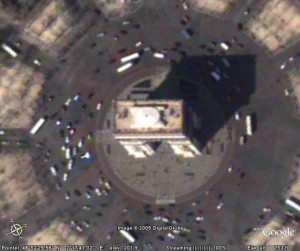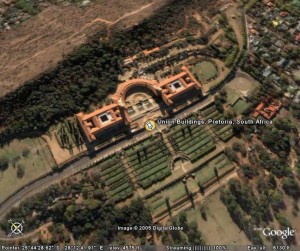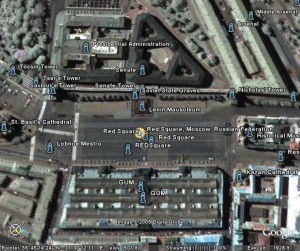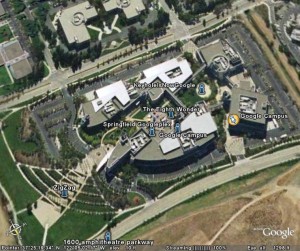 This absolutely blows my mind. With one simple download and a click of the mouse, I can literally zoom in from space on Moscow’s infamous Red Square, hovering less than 2,500 feet above St. Basil’s Cathedral and the ominous gaze of the Kremlin, as my computer pieces together terabytes of high-resolution satellite imagery from the urban landscape below.Then, with another subtle click, I’m flying back into space, and this time descend on one of the many sprawling banks of the raging Tigris River, closing in with crystal clarity on the now-empty walls of the National Museum of Iraq. Once home to some of the world’s greatest antiquities, the building is now just a depressing reminder of the often painful cost of Western “progress“.
This absolutely blows my mind. With one simple download and a click of the mouse, I can literally zoom in from space on Moscow’s infamous Red Square, hovering less than 2,500 feet above St. Basil’s Cathedral and the ominous gaze of the Kremlin, as my computer pieces together terabytes of high-resolution satellite imagery from the urban landscape below.Then, with another subtle click, I’m flying back into space, and this time descend on one of the many sprawling banks of the raging Tigris River, closing in with crystal clarity on the now-empty walls of the National Museum of Iraq. Once home to some of the world’s greatest antiquities, the building is now just a depressing reminder of the often painful cost of Western “progress“.
Next, it’s off to Paris for a remarkably crisp view of Napoleon’s own tribute to war, the colossal Arc de Triomphe. Complete with tiny european cars and their larger ‘touring’ cousins, Google Earth gets you close enough to almost smell the billows of smoke from all those fancy french cigarettes, burning away smugly on the nearby Champs-Élysées.
Then, before I know it, I’m barrelling back down on Tian’anmen Square, like those fateful Communist Tanks on that fateful Socialist Day back in 1989. It’s only after casting my gaze over Beijing’s other great tourist attraction, the (relatively) peaceful Forbidden City, that I’m able to press on through this stunningly visual tour of the globe.
 In rapid succession, I swoop over Christo Redentor in beautiful Rio de Janiero, followed by the Union Buildings in Pretoria, South Africa and the impressive Burj al Arab hotel in the new Vegas of the Middle East. But my last stop is perhaps the most disturbing of all. As the screen draws me down through the stratosphere and in toward the ground, my heart literally skips a beat.
In rapid succession, I swoop over Christo Redentor in beautiful Rio de Janiero, followed by the Union Buildings in Pretoria, South Africa and the impressive Burj al Arab hotel in the new Vegas of the Middle East. But my last stop is perhaps the most disturbing of all. As the screen draws me down through the stratosphere and in toward the ground, my heart literally skips a beat.
There in front of me, plain as day, is the roof of my very own house. The very house I’m sitting in as I hammer away at this article. In fact, so detailed was the satellite image of my neighbourhood block that I could actually distinguish the colour of my shingles, and at closer inspection, easily recognized the large American sedan parked in front of my closest neighbour.
Conspiracy theorists have been talking about technology like this for years, both in books and on screen, but for the first time in recent memory, it actually feels like we’re breaking through some fundamental technological barriers. In the case of Google Earth, those really rich guys out in Mountain View, California have taken 12+ terabytes (12,000,000+ megabytes) of declassified satellite imagery and arial photography from a company called DigitalGlobe and provided it free-of-charge to the general public. Or perhaps more accurately, they acquired a company called “Keyhole Inc.” that was already doing it, and effectively lowered the price to nothing.
“Good for them,” you might say. “Let them make the web easy, and useful, and fun. That way, everyone wins!” And believe me, many people will.
But there’s a darker side to the vast Google Empire, one that hovers just as ominously over the surface of the planet as their latest piece of inspired freeware. In fact, Google Labs has been hard at work developing and releasing all sorts of modern technological conveninces since the birth of the company just a few short years ago, some of which don’t necessarily fit the profile of a benificent technology champion.
For the sake of interest, I’ve compiled a short list to give you a taste of things to come:
Google Print (full text search of books)
Froogle (comparison shopping)
Google Moon (maps of the moon)
Google Scholar (academic research resources)
Google Video (streaming tv content)
Orkut (social networking)
Gmail (member-exclusive ad-supported high-storage email)
Picasa (photo editing/collection software)
Blogger (world’s most popular blogging host)
Urchin (tracking online traffic for fortune 500 companies)
Google RideFinder (limo/taxi finder)
Google Sets (automatic set creation from a few examples)
Google Web Accelerator (take a wild guess)
Google Compute (using your computer’s idle time to conduct massive collective research)
Android (mysterious mobile software developer)
GoogleNet (“free” ad-sponsored wi-fi for all of san francisco)
Well, you get the picture…
So what does it all mean? What could possibly be “sinister” about tracking down a limo service or chatting with your friends online? Well, just ask the folks over at Google Watch, or their outspoken webmaster, the so-called “Mr. Anti-Google”. His principal objection: Google’s search is undemocratic. But the knife cuts much deeper than that.
 Google’s meteoric rise to fame and fortune seems almost disturbingly familiar, and the incumbent software kings at Microsoft have definitely taken notice. But why does the world still despise Bill Gates’s 600 pound gorilla, while Google’s own 400 pound gorilla is able to stomp relatively undetected around the world wide web, gobbling up multi-million dollar companies like they were bananna-flavoured snacks?
Google’s meteoric rise to fame and fortune seems almost disturbingly familiar, and the incumbent software kings at Microsoft have definitely taken notice. But why does the world still despise Bill Gates’s 600 pound gorilla, while Google’s own 400 pound gorilla is able to stomp relatively undetected around the world wide web, gobbling up multi-million dollar companies like they were bananna-flavoured snacks?
The answer might have something to do with basic technological innovation, a little to do with style, and a lot to do with current trends in the use of personal computers. For starters, Microsoft copies things that other tech companies do better (like the omnipresent Windows, originally developed by the brainiacs over at Xerox Labs), while Google is best known for taking common problems (like finding information on the web) and making that process easier. More notably, Microsoft still charges often significant amounts of money for the use of its services, while Google’s basic business model is predicated on offering essentially free services that are complimented by user-specific, targeted advertising. In the end, both companies have made billions of dollars prividing seemingly essential services to millions of people worldwide, with only one meaningful difference: Microsoft is everywhere by force, and Google is everywhere by choice.
And that’s the really scary part: that the world actually chooses Google over its competition in fairly startling numbers. Late in 2004, a mere 8 years after co-founders Page and Brin finished their graduate research project at Stanford, Google was handling over 80% of the world’s online search traffic. Later that same year, united under the corporate motto “Don’t be Evil“, the company also went public with an unconventional “Dutch auction” offering that raised the firm’s founding fathers almost a billions dollars for their troubles, and also furnished Google Inc. with an additional two billion in new capital for good strategic measure. So what do they need with all that money, and where do they plan on spending it?
 In all likelihood, Google will continue to explore strategic investment opportunities in the burgeoning world of high-bandwith cyberspace, and some of them may even make our lives a little better. But with the company now worth over $75 billion dollars (and climbing), a considerable cash war chest at their immediate disposal, a stated policy of never deleting its “anonymous” user statistics, and a penchant for targeted acquisitions within the considerably delicate realm of information procurement/provision, Google seems poised to become the next information juggernaut on the proverbial Silicon Block. Products like Google Earth and Google Compute might seem harmless enough today, but what happens when Google Genome is launched? Or even Google War?
In all likelihood, Google will continue to explore strategic investment opportunities in the burgeoning world of high-bandwith cyberspace, and some of them may even make our lives a little better. But with the company now worth over $75 billion dollars (and climbing), a considerable cash war chest at their immediate disposal, a stated policy of never deleting its “anonymous” user statistics, and a penchant for targeted acquisitions within the considerably delicate realm of information procurement/provision, Google seems poised to become the next information juggernaut on the proverbial Silicon Block. Products like Google Earth and Google Compute might seem harmless enough today, but what happens when Google Genome is launched? Or even Google War?
In the end, as those sky-bound cameras gaze down longingly at that sprawling California campus, where the next great rulers of the information age plot the future of our digital world, all we can really do is sit back and quietly hope that they wield their power wisely. If they don’t, at least we’ll have a bunch of free ad-sponsored software to help us watch the apocalypse unfold.